#colonial ceylon
Explore tagged Tumblr posts
Text
Pt.2 of the collection of Sri Lankan stamps
(These stamps were issued during the colonial era of Sri Lanka. Correct me if I am wrong)










#Sri Lanka#Ceylon#colonialism#nationality#Britain#british royal family#Sinhalese#Tamil#tea#island#culture#postal stamps#stamps#stamp art#art#Sri lankan culture#unity#temples#Anuradhapura#tea plantation#Ceylon tea#colonial Sri Lanka#colonial Ceylon#old Ceylon#queen#queen elizabeth ii#king george iii#king george v#England#English
17 notes
·
View notes
Text
#tamil indentured history#sri lanka#colonial ceylon#malayaha tamil#plantation tamils#sadhees selvaraj
8 notes
·
View notes
Video
youtube
RAVANA'S LANKA: The Landscape of a Lost Kingdom | సముద్ర గర్భంలో కలిసిపోయిన రావణ లంక!...
#youtube#రావణ లంక#RAVANA'S LANKA#sri lanka#lanka#lost kingdoms#lost kingdom#The Landscape of a Lost Kingdom#Landscape of a Lost Kingdom#ram setu#valmiki ramayana#dhanushkodi#Kumari Kandam#geographical evidence#voice of maheedhar#Historical Name Changes#prime meridian#ancient astronomy#submerged lands#sinhala#ceylon#cyclones#colonialism#ancient tamil texts#manimekalai#silappathikaram#indian history#modern research#lost city#lost lanka
0 notes
Text
This was written less than seven months before the deposed Rajapaksa family orchestrated the Easter Sunday Attacks. The virulent Islamophobia that followed in their wake saw two Muslim towns burned down, hundreds of innocent Muslims incarcerated, and won the Rajapaksas two landslide elections that secured them dominance of all three branches of government, paving the way for the historic 2022 Sri Lankan economic collapse.
I heard the voice of the devil today.
I was not prepared for it. The priest’s voice was light and smiling and friendly. There was no stuffiness I remembered from the droning of my stifling school days. He invited us to relax, made gentle jokes and emphasized the value of focusing on the intent of the doctrine rather than its letter and traditions.
I learned to trust that voice within minutes and had relaxed into it’s hold when it continued on in the same calm, considered way.
“We heard reports of a Muslim hotel that was sprinkling some suspicious powder on the food sent to our people. So we investigated, and we found that this was a medicine designed to induce barrenness. Or perhaps simply delay conception. Our people protested and had it shut down in due time. But now apparently a powerful politician is trying to have it re-opened.
So the people of the community came to me. They said, “Reverend, this minister is a friend of yours. His son goes to your Sunday school. He respects you. Please tell him how these Muslims persecute us. Change his mind.” Now, I do not know if I have any sway over the rich and powerful. This is not what I usually do, you understand. But I said I would try and speak to him. And I did, as a friend. I explained to him the persecution our community has been facing from these Muslims, and the terrible thing we caught them doing. He said something that I found very funny and true. “Reverend, these people are the ones who give me votes, give me funds for my campaign. What have our people done for me?” *laughter* And I have to agree with him. The blame lies with us. If we don’t stand by our own communities, why should anyone else?“
The words themselves seem so bland and diminished on the page. They weren’t loud or affecting or heart-stirring. It was all in the confident inflection. When he said "investigated” it immediately conveyed the image of a team of government officials and medical experts that had gone in and assessed the situation. “Sterilization medicine” said as though he had been looking over a doctor’s shoulder as they examined it. “Or perhaps simply delay conception” cast just enough reasonable doubt to sound like science, as though it had been explained to him by an expert although he himself was limited in understanding, humble priest that he was. But with the casual certainty sterilization powder is a commonly known thing that exists, instead of a fairy dust that would save the lives of women all over the world when birth control and hysterectomies are denied.
Lie upon lie upon lie delivered in the calm, reasoning cadence of a guest lecturer, with that horrible ring of impartial truth.
I thought I had seen the source of this hate and these awful lies. They were the red-faced priests at the front of mobs, spittle flying into TV microphones as they shook their fists and shouted into thunderous applause. You could almost see the marionette strings and hear the rustle of money under their robes.
“How can they possibly believe this baboon? Just look at him!” I wondered. “Stupid people love a circus,” they said, shaking their heads sagely. “Educated people don’t stand for that sort of thing. Just ignore them.”
So I was not ready to hear it in that lovely, learned voice in the home of my friend. I was not ready to look around and see the roomful of somberly-dressed venerable retirees, successful executives, brisk community organizers who lived in the uptown of a multi-ethnic city, all listening intently with bowed heads as the blood drained from my own face and I waited desperately from some sort of punchline. I was not ready to realize that my friend’s kindly aunt who had pressed my hijabi Muslim friend’s hand last week and thanked us for coming to dinner was probably the one who had invited this priest.
On the way home I remembered the patterns of genocide, emerging like a waiting sandbar through time. How the cycle had started in my own country years before, when the powerful crushed the spine of the poor under their boot and glutted themselves on the marrow of our economy. How they deflected the anger of a starving mob onto an innocent minority they had spent years stoking the embers against. How it crested with people burned alive in tyre fires, homes burnt with families inside, a screaming people driven into the arms of a militia that demanded the lives of their children in exchange for self-determination. How it had driven the boys and men of both sides on parades of patriotism and heroism right into the waiting arms of death, a generation of trusting lambs herded to a slaughterhouse. How it had ended again less than a decade before in a hundred thousand corpses running red in the sea salt and silt of No Man’s Land. How the trauma of three generations now run in the blood of newborns.
How dare indeed our wombs go barren when we have a million children to bleed for them.
I heard the voice of the devil today and I told them what I heard.
“How awful! I suppose they felt they had to be polite,” they said. “Educated people don’t harbour hatred; it’s the uneducated slobs who get emotional and create all this havoc. There will always be petty-minded racists. Just ignore them.”
#if it sounds like antisemitic tropes that's because it is#the British colonials of Ceylon cut and pasted antisemitic propaganda onto its population of Muslim moors#that follows them to this day#sri lanka politics#islamophobia#knee of huss#easter sunday attacks#ethnosupremacy
23 notes
·
View notes
Text
The Slavery Abolition Act didn’t apply to India or Ceylon, and though it technically liberated over 800,000 British slaves in the Caribbean and Africa, all of them (excepting only small children) were forced to continue to labor as unpaid “apprentices” for a further six years, on pain of punishment. Under the terms of the act, they were protected against overwork and direct violence from employers, but remained their “transferable property,” subject to punishment for “indolence,” “insolence,” or “insubordination.” So many black West Indians were jailed for resisting these outrageous terms that full emancipation was eventually brought forward to August 1, 1838. [...] A century on, the independence of most Caribbean colonies in the 1960s was followed by decades of racist British immigration policies that not only sought to prevent black West Indians from coming to the UK but eventually, under the Conservative governments of the past decade, ended up deliberately destroying the lives of thousands of lifelong legal residents by treating them as “illegal migrants.” In the meantime, for almost two hundred years, British taxpayers funded the largest slavery-related reparations ever paid out. Under the provisions of the 1833 act, the government borrowed and then disbursed the staggering sum of £20 million (equal to 40 percent of its annual budget -- the equivalent of £300 billion in today’s value). Not until 2015 that debt finally paid off. This unprecedented compensation for injustice went not to those whose lives had been spent in slavery, nor even to those descended from the millions who had died in captivity. It was all given to British slaveowners, as restitution for the loss of their human property.
Text by: Fara Dabhoiwala. “Speech and Slavery in the West Indies.” The New York Review of Books. 20 August 2020. [Published online at: nybooks.com/articles/2020/08/20/speech-slavery-west-indies/]
1K notes
·
View notes
Text
One of the major legacies of the British control of India was the planting of peoples of Indian origin all over the British Empire, including Britain itself. India was considered to be a reservoir of cheap labour. After African slavery was legally ended in 1833, ‘indentured’ labourers were recruited from India to work on plantations in Mauritius, Guyana, Trinidad, and Jamaica. This was slavery in a new guise: many laboured under conditions no less degrading than slavery. Thereafter wherever need arose, Indian labour was employed. Indians worked in the plantations and mines in Ceylon, Malaya, Burma, South Africa and Fiji. Indian labour provided the manpower to build the East African Railway. Indian sailors worked the British merchant navy. Indian soldiers not only helped to maintain the British Raj in India, but were used as cannon fodder overseas in colonial wars of conquest to extend its frontiers.
Indians were brought to Britain too. They did not come as ‘indentured’ labourers, but the principle of cheap labour applied here as well. Many Indian servants and ayahs (nannies or ladies’ maids) were brought over by British families returning from India. Indian sailors were employed by the East India Company to work on its ships. Some of these servants and sailors settled permanently in Britain.
One of the results of the policy of introducing western education in India was that, from about the middle of the nineteenth century, many Indian students began arriving in Britain, some on scholarships, to study law or medicine or to prepare for other professions. Some came to take the examination for entry into the Indian civil service since this examination could only be taken in London. Some Indian students settled in Britain after qualifying, to practise as doctors, lawyers or in other professions. Some Indian business firms opened branches in England. Nationalist politicians came to London, the centre of power, to argue the cause of Indian freedom. Indian princes and maharajahs visited England, not only as guests of the Crown on formal occasions, like the coronations, but also to pay their ‘respects’ to the monarch or for pleasure. London, as the metropolitan capital, attracted many visitors from India. Exhibitions of Indian arts and crafts were displayed in England too. The Asian presence in Britain therefore goes a long way back and forms a prelude to the post-independence migration of Asians to Britain.
— Rozina Visram, Ayahs, Lascars and Princes: Indians in Britain, 1700-1947 (London: 1986), pp. 9-10.
158 notes
·
View notes
Note
what are the different regions that Britain conquered? I know that Wales and Ireland are two, but I don’t know where to begin of looking into the different cultures?
"Britain" never conquered Ireland, nor Wales or Scotland. The English invaded and occupied them, the concept of Britain did not exist at this time.
Britain also occupied:
Egypt
Sudan
South Africa
Nigeria
Kenya
Uganda
Ghana
Zimbabwe (formerly Rhodesia)
Asia
India
Pakistan
Bangladesh
Myanmar (Burma)
Malaysia
Singapore
Sri Lanka (Ceylon)
Hong Kong
Americas
Canada
United States (13 original colonies)
Jamaica
Barbados
Bahamas
Trinidad and Tobago
Guyana
Australia
New Zealand
Fiji
Papua New Guinea
Europe
Malta
Cyprus
Botswana (Bechuanaland)
Lesotho (Basutoland)
Swaziland (Eswatini)
Malawi (Nyasaland)
Zambia (Northern Rhodesia)
Tanzania (Tanganyika and Zanzibar)
India
Pakistan
Bangladesh
Myanmar (Burma)
Malaysia
Singapore
Sri Lanka (Ceylon)
Hong Kong
Maldives
Brunei
Yemen (Aden)
Iraq
Kuwait
Jordan
Palestine
Canada
United States (13 original colonies)
Jamaica
Barbados
Bahamas
Trinidad and Tobago
Guyana
Belize (British Honduras)
Bermuda
Saint Kitts and Nevis
Antigua and Barbuda
Saint Lucia
Saint Vincent and the Grenadines
Grenada
Dominica
Cayman Islands
Montserrat
Falkland Islands
Oceania
Australia
New Zealand
Fiji
Papua New Guinea
Solomon Islands
Vanuatu (New Hebrides)
Tonga
Samoa (Western Samoa)
Kiribati (Gilbert Islands)
Tuvalu (Ellice Islands)
Nauru
Europe
Malta
Cyprus
Gibraltar
United Arab Emirates (Trucial States)
Qatar
Bahrain
Oman (Muscat and Oman)
Seychelles
Mauritius
Maldives
Caribbean
Anguilla
British Virgin Islands
Cayman Islands
Montserrat
Turks and Caicos Islands
33 notes
·
View notes
Text
Speaking of decolonization, why hasn't the Philippines changed it's name yet? Spain no longer owns the islands, why is it still named after their King? Myanmar, Sri Lanka and Zimbabwe have all changed their names from the colonial names Burma, Ceylon and Rhodesia in recent history. It's time for the "Philippines" to do the same.
#i don't got any bright ideas what to change it too tho#any thoughts?#philippines#filipino#filipinas#pinoy#decolonization#spanish#español#others proposed Maharlika#maharlika
30 notes
·
View notes
Text
Minnette de Silva is my Roman Empire and here is why.

It’s 1918, Sri Lanka is still known as Ceylon, a British Colony and the last place you’d expect to find feminist ground breaking artistic pioneers. Minnette de Silva is born and concurs.
One of the first modernist architects to come from Sri Lanka AND the first Asian woman to become an Associate of the Royal Institute of British Architects.
She was awarded the SLIA Gold Medal for her contribution to architecture “regional modernism for the tropics”
She did not complete her formal education due to family circumstances. Despite not finishing the modern equivalent of her A-Levels, she undertook an apprenticeship and attended lectures at the Ceylon Technical College (Desi kids rejoice at an intellectual icon who had an untraditional path through education). She then joined the Sir Jamsetjee Jeejebhoy School of Art which allowed her to study under many influential architects.

She was eclectic, intelligent and a force to be reckoned. She was expelled from the Government School of Architecture in India for attending a Free Gandhi March and refusing to write an apology letter to the Head of the School for it (we don’t stan Gandhi but we do stan standing up for your beliefs!)
Her father was extremely opposed to her career path but she went for it anyway. A bad bitch. An unstoppable force.
According to The Guardian “During her time at the Architectural Association (AA) in the UK she cut an elegant figure, draped in silk saris and followed by a train of young male students bearing her bags and instruments.”

This is how I imagine her walking down those halls!
Minnette de Silva returned to a newly independent Sri Lanka in 1949, and established her career in Kandy. She was influenced by Ananda Coomaraswamy, and advocated for the preservation of the traditional methods of craftsmanship, construction, and acquiring materials. She was inspired to create a style that incorporated the newly Western methods of development with the natural style, aesthetic, and landscapes of the tropical island.
The photos below are her designs and they are
e x q u i s i t e ✨


She never married. According to Architectual Record Minette explained to a friend “husbands are only good for carrying one’s bags”

My real life reaction to reading THAT quote🔥
However, Minette was always plagued by financial insecurity, she died penniless in a hospital in Kandy on the 24th of November 1998 at the age of 80. She had fallen from her bathtub at home, and was not found for days. Only a relative few of her building remain standing.
RIP Minette de Silva, you were a pioneer and an inspiration.
#sri lanka#dark academia#sri lankan culture#desi culture#light academia#museums#sri lankan history#history#architecture#inspirations#poc dark academia#sri lankan dark academia#poc academia#women history#i’m back bitches
31 notes
·
View notes
Text

Buddha Mind
“Our life is shaped by our mind; we become what we think. Suffering follows an evil thought as the wheels of a cart follow the oxen that draws it.
Our life is shaped by our mind; we become what we think. Joy follows a pure thought like a shadow that never leaves.” --Gautama Buddha
All sentient beings reside in the compassionate mind of the Buddha. Likewise, all the Buddhas dwell in our minds, because our True Nature is the Nature of Buddha.
35 notes
·
View notes
Text
- A collection of Sri Lankan postal stamps :)










#sri lanka#ceylon#island#stamps#postal#postal stamps#culture#Sinhalese#Tamil#nation#nationality#I LOVE MY COUNTRY#lion#old Ceylon#colonial Sri Lanka#Sri lankan liberation#freedom#independence#peacock#blue lotus
9 notes
·
View notes
Note
hi! any reading you'd rec on bio politics\necro politics? i've recently gotten curious about the concepts so forgive if this is vague or not specific lol. tyy in advance ! hope ur day is good
so, the standard recs you will usually see for getting a theoretical foundation here are:
Foucault's 1978–9 lecture series at the Collège de France, "The Birth of biopolitics", and his 1975–6 series, "Society must be defended" (there are print series of his lectures) (<-these are honestly overrated as sources imho b/c foucault never fully developed these concepts. i would read lecture 11 from the 75–6 series if you absolutely feel you need some foucault, and then skip to whatever else seems interesting)
Achille Mbembe's Necropolitics (2019)
Jasbir Puar's The Right to Maim: Debility, Capacity, Disability (2017)
there are also lots and lots and lots of books that use concepts of bio/necropolitics in their historical and/or political arguments. some i've enjoyed include:
Joshua Cole, The Power of Large Numbers: Population, Politics, and Gender in Nineteenth-Century France (2018: Cornell University Press)
Daniel Nemser, Infrastructures of Race: Concentration and Biopolitics in Colonial Mexico (2017: University of Texas Press)
Andrew Aisenberg, Contagion: Disease, Government, and the "Social Question" in Nineteenth-Century France (1999)
Mie Nakachi, Replacing the Dead: The Politics of Reproduction in the Postwar Soviet Union (2021: Oxford University Press)
Banu Subramaniam, Holy Science: The Biopolitics of Hindu Nationalism (2019: University of Washington Press)
Kyla Schuller, The Biopolitics of Feeling: Race, Sex, and Science in the Nineteenth Century (2017: Duke University Press)
Michela Marcatelli, Naturalizing Inequality: Water, Race, and Biopolitics in South Africa (2021: University of Arizona Press)
Ellen Amster, Medicine and the saints: science, Islam, and the colonial encounter in Morocco, 1877-1956 (2013: University of Texas Press)
Ron Broglio, Beasts of Burden: Biopolitics, Labor, and Animal Life in British Romanticism (2017: SUNY Press) (<-doubles as an introduction into why the 'animal turn' has been such a hot topic historiographically in the past 5 or 6 years)
James Duncan, In the Shadows of the Tropics: Climate, Race and Biopower in Nineteenth Century Ceylon (2007: Ashgate)
René Dietrich & Kerstin Knopf (Eds.), Biopolitics, geopolitics, life: settler states and indigenous presence (2023) (<-haven't read this yet! some of these essays look very promising)
#book recs#biopolitics#there is also a very interesting chapter in nükhet varlık's book on ottoman empire & plague that makes an argument for usage of#the biopolitics framework centuries prior to the 'classic' 19thc case study. however varlık's book is very long and mostly not about that
137 notes
·
View notes
Text
Happy Emancipation Day!
Here's a short write up I did about Emancipation Day for my local grassroots mutual aid collective. This will unfortunately be focused primarily on Canada because our area of influence is more local than international. Please be sure to educate yourself on what this day means in your region!
What is the Slave Abolition Act of 1833?
The Slave Abolition Act of 1833 was a British law that ended slavery in most British colonies, freeing over 800,000 enslaved Africans in the Caribbean, South Africa, and Canada. The law, approved on August 28, 1833, took effect on August 1, 1834. It did not immediately apply to territories controlled by the East India Company, Ceylon, or Saint Helena; these exceptions were removed in 1843.
Earlier, in 1793, John Graves Simcoe, the first Lieutenant Governor of Upper Canada (now Ontario), had passed an Act Against the importation of new slaves. This law promised freedom to children born to enslaved women at age twenty-five, but it did not free existing slaves. The Slavery Abolition Act of 1833 later replaced this law, ending slavery across most of the British Empire.
Did it really free the slaves?
The Slavery Abolition Act had its flaws. It only freed those enslaved under age six. Older individuals were classified as 'apprentices' and had to work 40 hours a week without pay as “compensation” to their former slave owners. Full emancipation was not achieved until July 31, 1838.
While Canada often expresses pride in its relatively lesser involvement in slavery when compared to other British colonies, it wasn't the first to end it. The Independent Republic of Vermont was the first in North America to abolish slavery with its 1777 constitution. This came 16 years before Upper Canada’s partial abolition in 1793. Vermont was quickly followed by states like Pennsylvania and Massachusetts, and the U.S. Congress banned slavery in future Midwest territories in 1787.
What is Emancipation Day? What does it mean?
On March 1, 2021, the Canadian House of Commons unanimously declared August 1 as Emancipation Day. This date marks the beginning of the partial abolition of slavery across British colonies in various countries.
Why is Emancipation Day important?
Neglecting acknowledgement of Emancipation Day allows Canada to evade its dark history and distort its legacy. We must hold governments accountable for the history of their crimes. It’s critical to confront the reality that slavery was a part of Canadian history and that its legacy continues to impact African Canadians today. While Canada often boasts about its role in the Underground Railroad and its “total” abolishment of slavery before the U.S, it must also face the uncomfortable truth of its own very real involvement in slavery. Emancipation Day is about confronting history with honesty. Acknowledging this day is essential for addressing past injustices and ensuring that future generations grasp the full, unfiltered truth of Canada's history, including the painful chapters that must not be forgotten or repeated.
Emancipation did not end the oppression of Black people in this country. For those who suffered under centuries of slavery, emancipation should have signaled that Canada would become a place of respect and opportunity for their descendants. Instead, Black Canadians still face racism, discrimination, and prejudice in education, healthcare, housing, and the justice system.
The history of slavery and the stories of enslaved people and their descendants have historically been confined to Black communities. Recognition of this day on a national scale not only helps to validify the black experience, but also to clearly acknowledge our refusal to return to these oppressive norms. Integrating this crucial part of Canadian history into the education of all our children is vital for addressing anti-Black racism and its ongoing impact in our society to this day. A necessary step toward justice is issuing an official apology to the descendants of enslaved people, bringing this issue to the forefront of Canadian awareness and starting the path toward meaningful reparations.
Emancipation day allows us the opportunity to use the past to reflect upon the present. We must acknowledge the deep, ongoing trauma from slavery and segregation as the foundation of anti-Black racism that is still rampant in our justice system today. It is only through this acknowledgement that we can begin to form a dialogue which sees black people as an important, intrinsic part of Canadian history at all times, not just during black history month.










#blacklivesmatter#emancipation#radical education#mutual aid#police abolition#history#pagan#paganism#racial justice#social justice#black history#black indigenous#canadian history#black lives matter#revolution
21 notes
·
View notes
Text
Princess Anne’s visit reinforces Sri Lanka-UK bonds - Plaudits for hard work and modest outlook
Published 14th January 2024
By Pramod de Silva
The British Royal Family is changing their outlook following the demise of Queen Elizabeth II and amidst increasing calls for truncating or even abolishing the monarchy.
Indeed, gone are the days when the British Empire was known collectively as a region where the “Sun never sets” as its colonies were located all over the globe, from Sri Lanka (then Ceylon) to South Africa. Now there are only a very few British protectorates left, including the Falklands Islands. All others have either become Dominions with King (Charles III) as the titular Head of State (examples include Canada and Australia) or Republics with no sovereign ties to the British King, such as Sri Lanka and India.
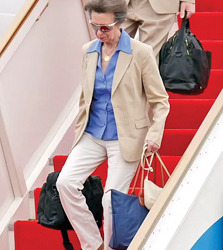
A humble Princess Anne carried her own bags off the plane as she arrived at the Bandaranaike International Airport in Katunayake with her husband Vice Admiral Sir Timothy LaurenceA humble Princess Anne carried her own bags off the plane as she arrived at the Bandaranaike International Airport in Katunayake with her husband Vice Admiral Sir Timothy Laurence.
Yet, the British Royal Family maintains a measure of popularity in the so-called Commonwealth Countries, which are former colonies of Britain, even if their fame has taken a hit in the UK itself particularly following the death of Princess Diana, and the separation of Prince Harry and his wife Meghan Markle from royal life. The couple has since been living in California, USA.
Queen Elizabeth II’s visit
Sri Lankans, for whatever reason(s), do have a soft corner for the British Royal Family, in spite of the mixed colonial legacy in the country. This was evinced when Queen Elizabeth II arrived here for the first time in 1954. This visit was significant for two reasons. The first was that Sri Lanka hadsaman gained Independence from Britain just six years earlier, in 1948. And Sri Lanka was still a Dominion back then.
The second was that this was one of the Queen’s first official overseas visits after her Coronation on June 2, 1953. She wore her Coronation Frock at one of the events in Colombo during this tour. She would go on to occupy the Throne for nearly 70 years. Her next visit to Sri Lanka was in 1981, by which time the country had become a Republic. But judging by the raucous reception she received wherever she and Prince Philip went, her popularity in Sri Lanka was intact.
In between those two visits, the couple became the proud parents of four children – Princes Charles (the present King), Andrew (Duke of York, though now mostly retired from Royal Duties following a string of scandals), Edward (Duke of Edinburgh) and Princess Anne, now known officially as Princess Royal. She thus happens to be the only daughter of Queen Elizabeth.
It is no secret that Princess Anne is the sibling closest to King Charles, ever-ready to steady the ship amidst the turbulent storms that the Royal Family faced in the years following the tragic death of Princess Diana in Paris in 1997. Her scandal-free life and easy going nature had endeared herself to Royal fans all over the planet.
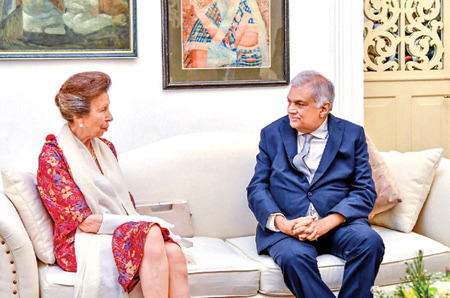
This might explain the buzz surrounding last-week’s official visit of Princess Anne to Sri Lanka to mark 75 years of diplomatic links between the two friendly countries. Given the revolving door that is Number 10, one cannot imagine a better ambassador to mark this occasion than apparently someone from Buckingham Palace – and the hardest working member of the British Royal Family at that. Princess Anne has earned that moniker from the press thanks to her non-stop work for good causes around the world.
A royal expert has explained why the Princess Royal was chosen as the first member of the family to go away in 2024, as she was praised as being “invaluable” to King Charles. Richard Fitzwilliams said: “Princess Anne is an example of what the public most admire in a working royal, she is dedicated, conscientious and prefers a low profile and no fuss.”
First-ever Royal visit for 2024
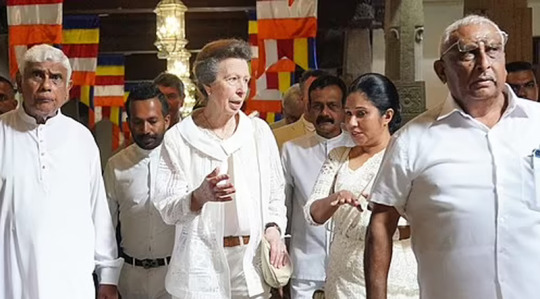
Princess Anne began the second day of her Sri Lanka tour with a visit to the Sri Dalada Maligawa (Temple of the Sacred Tooth Relic) in KandyPrincess Anne began the second day of her Sri Lanka tour with a visit to the Sri Dalada Maligawa (Temple of the Sacred Tooth Relic) in Kandy
In fact, her trip to Sri Lanka gained international media attention due to several reasons, with magazines such as Hello! And People devoting multiple pages to the coverage, not to mention all mainstream British newspapers. After all, this was the first-ever overseas visit by any Member of the Royal Family for 2024. Princess Anne is no stranger to Sri Lanka, having visited the country previously in 1995, as a patron of the Save the Children Fund.
The media were quick to highlight the fact that Anne (73) and her husband Vice Admiral Sir Tim Laurence (68) flew on a commercial airline to Colombo, whereas they could have requested a Government Airbus A330 or other aircraft from the Royal Air Force (RAF). In fact, SriLankan Airlines, the only carrier which flies directly between London (LHR) and Colombo (CMB) could not hide its delight, posting on X under the headline “A Service Fit for a Royal”.
A SriLankan Airlines post said: “We are delighted to welcome onboard Her Royal Highness (HRH) the Princess Royal on her journey from London to Colombo on a three-day official visit to mark 75 years of diplomatic relations between Sri Lanka and the UK. It is truly an honour to extend Her Royal Highness and the delegation our inherent Sri Lankan warmth and hospitality, thereby presenting the first taste of our island home through our service. We thank the HRH for honouring us with her presence onboard and choosing us for the journey.”
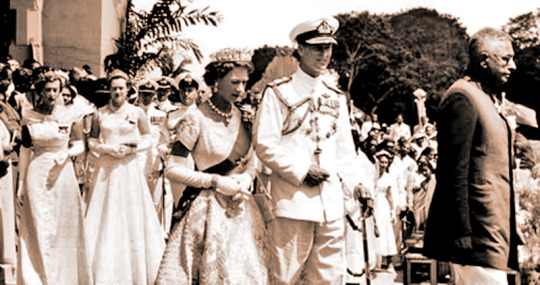
Royal commentators and observers were also delighted to note that the couple carried their own bags, both at the points of embarkation and disembarkation. Princess Anne and Sir Tim’s down-to-Earth nature was displayed by them carrying their own bags onto the flight, the commentators said. One eagle-eyed royal writer even noted that one of her bags was from the French brand Longchamp’s La Pliage Line, costing just 115 Sterling Pounds, at a time lesser mortals like to show off bags from the likes of Louis Vuitton costing thousands of pounds or dollars.
A welcome ceremony at the airport saw the two Royals greeted by dancers, music, Union Jack flags and a red carpet. Princess Anne, sporting sunglasses, was received by dignitaries including the British High Commissioner Andrew Patrick and Minister of Foreign Affairs Ali Sabry, PC.
Princess Anne and Sir Tim kicked off their engagements right away, heading first to the MAS Active Factory near the Airport, one of the largest apparel tech companies in South Asia and identified by the UK Fashion and Textile (UKFT) Association as an important Sri Lankan partner. As President of the UKFT, the Princess Royal met staff and toured the facility to hear more about their innovative designs and partnerships with leading UK brands.
Princess Anne, Princess Royal signs the golden book after she arrives for a three-day official visit to Sri Lanka at the BIA in KatunayakePrincess Anne, Princess Royal signs the golden book after she arrives for a three-day official visit to Sri Lanka at the BIA in Katunayake.
Letter from King Charles
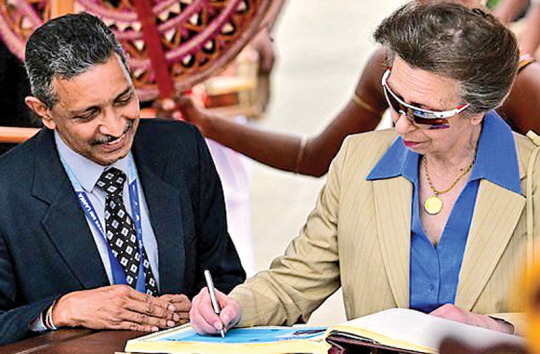
The couple also met President Ranil Wickremesinghe and Prof. Maitree Wickremesinghe at the President’s House. Her brother King Charles had outlined “considerable challenges” that the world is facing in a letter delivered by Princess Anne to President Wickremesinghe during this meeting.
The Royal Couple also got the opportunity of meeting former President Chandrika Bandaranaike Kumaratunga on this occasion. She was the incumbent President when Princess Anne last toured the island in 1995. Royal watchers praised the Princess’s modest outfit worn to this important event. Hello! Magazine described her outfit in this manner: “Putting on a colourful display, the Princess Royal asserted her sartorial prowess in a ravishing red shift dress adorned with blooming pastel flowers. For an additional pop of colour, the royal added a berry-red lipstick, balancing her ensemble with a draped cream scarf and white gloves.” Another royal watcher said that her white gloves worn at the event were a subtle nod to the legacy of her mother.
Princess Anne, with her lifelong affinity to the Save the Children Fund, also took time off her busy schedule of meetings to visit its offices in Colombo and inquire into their programs in Sri Lanka. After unveiling a plaque commemorating the 50th anniversary of Save the Children working in Sri Lanka, she gave an impromptu speech to staff and guests at the charity’s Colombo HQ.

Princess Anne said: “It’s a real pleasure to return to Sri Lanka and the chance to visit Save the Children’s (headquarters) and underline the fact you have been doing extraordinary work here for 50 years.’ And I know, because when I came before it was slightly different, things have changed a lot. But the very fact that you are here and seen as valuable partners to the Government and the departments – that says a lot for what you’ve achieved…So a big thank you to all those who have been part of that journey, thank you all very much.” She also visited the Lady Ridgeway Hospital (LRH) in Colombo.
Princess Anne paid her respects to the Fallen Heroes of World Wars when she laid a wreath in their memory in Colombo, during her first visit to a Commonwealth War Graves Commission (CWGC) cemetery in the Jawatta area as the organisation’s President. They also visited the nearby Vajira Pillayar Hindu Kovil, where Sir Tim dashed a coconut to ward off bad luck. Chief Priest Sachithanantha Kurukal went into the shrine to conduct the pooja as Princess Anne and her husband watched, and they later toured the temple viewing the many shrines to Hindu Gods.
The Royal Couple then left for Kandy, where they paid homage to the Sacred Tooth Relic of the Buddha at the Sri Dalada Maligawa. Dressed in white, Princess Anne was ushered into an inner sanctum, reserved for the temple’s most important guests, to make her offering to the Sacred Relic in private.
Princess Anne engaged in a friendly conversation with Former President Chandrika Bandaranaike KumaratungaPrincess Anne engaged in a friendly conversation with Former President Chandrika Bandaranaike Kumaratunga
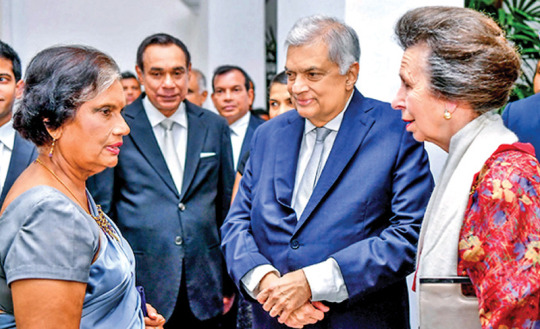
Later, the couple travelled to Jaffna, where they toured the famous Jaffna Public Library, which was burnt down by mobs in 1981 and then rebuilt to reflect its former glory. The couple toured the library “where they heard of its significance to the community and met key figures from the fields of education, arts and culture,” said the British High Commission in Sri Lanka. Andrew Patrick, British High Commissioner to Sri Lanka, called the building “a landmark of great significance”. “This important moment marks the first visit by a member of the Royal Family to Jaffna,” he added.
The library was one of the largest libraries in Asia and housed over 97,000 unique and irreplaceable palm leaves books (ola), manuscripts, parchments, books, magazines and newspapers, before its destruction in 1981.
The couple had several other engagements in Sri Lanka before they flew back to the UK after a highly successful visit, which reinforced UK-Sri Lanka ties. Several more events will be held in 2024 to mark this milestone.
Princess Anne’s Sri Lanka visit is her second official engagement of this year, having returned to duties on January 4 to attend the Oxford Farming Conference.
The King and Queen are also set to fly overseas later this year. The couple are expected to visit Canada in May, before flying to Australia, New Zealand and Samoa in October.
As for the Prince and Princess of Wales, they too will be preparing to return to Royal Duties in the coming week, which comes after the family celebrated Princess Kate’s 42nd birthday on Tuesday January 9.
#a lovely summary of an excellent trip 💗#princess anne#princess royal#tim laurence#timothy laurence#sri lanneka
25 notes
·
View notes
Text
“A generation which ignores history has no past -- and no future.”
The National Centre for Social Research Centre's Social Attitude survey, finding that there has been a sharp decline in British national pride in the last decade has driven the pundits and politicians on the right into displays of righteous indignation.
Peoples pride in being British has fallen from 83% in 1995 to 64% in 2023. Only 53% think democracy works well in this country, down from 60% in 1995, and only 49% would rather be a British citizen than any other country, a decline of 20% since 1995. What has particularly agitated those on the right is the finding that pride in British history has dropped from 86% in 2013, to 64% in 2023.
Nigel Forage, never one to miss an opportunity for self-promotion, went on a “blistering rant" concerning the decline of national pride in British history, claiming he has been “railing against" an education establishment that is constantly "talking down Britain’s past”.
What’s happened claims Forage is there has been a “Marxist take-over, of people that hate the country, hate what it stands for, and they have done their job” Primary school teachers, secondary school teachers and university lectures all “rejoice” in putting Britain down.
Who would have thought it? That seemingly lovely Mrs Jones, who does so much for the infants in her care, a revolutionary Marxist. The dusty secondary school history teacher Mr Smith, also a Marxist, just waiting to advance the communist revolution on the streets of Britain. Unbelievable! And as for all of those university academics…just don’t get me started.
What a load of utter piffle Mr Farage. But he knows that. What he is doing is dog whistling as usual.
Taking the teaching of slavery as an example , Forage condemns the educational establishment for teaching that Britain was “the only country in the history of mankind that had ever conducted slavery.” What’s more says Forage, Britain "far from being the one nation, actually, that ended it,..lost a lot of money and a lot of lives driving it out."
Lets examine these claims.
First, no one has ever said that Britain was the only slave-trading nation. Portugal, France, Spain, Netherlands, USA and Denmark ALL profited from slaves.
Second, Forage was right in asserting that Britain was one of the first major European powers to officially abolish slavery. The Abolition of Slavery Act was passed inn 1833 but not all British owned slaves were covered by this act as it specifically excluded many slave colonies owned by the East India Company and British slaves on the islands of Ceylon and St Helena.
Third, British sailors did die fighting the slave trade but nowhere near as many as has been claimed on social media. Fullfact.org, state that the figure of between 17,000 and 20,00 Royal Navy sailors dying fighting illegal slave traders is untrue, the figure being much nearer 2000.
Forth, did driving out slavery cost a lot of money? Yes it did, but none of the money went to the slaves themselves, only to the slave owners as compensation for their losses.
Despite the repugnant and morally corrupt practice of slave ownership that the 1833 Abolition of Slavery Act represented, a mere four years after this law came into being another piece of slavery legislation was enacted: the Slave Compensation Act 1887.
This is something Forage and those other millionaires and billionaires on the right of British politics often neglect to tell us. Despite the repugnant and utterly immoral practice of slave ownership implicit in the Abolition of Slavery Act 1833, this new act ordered the Commissioners for the Reduction of the National Debt to compensate slave owners in the British colonies to the tune of £20 million pound – around £17billion pounds today. This payout was a massive 40% of total government budget.
What else Forage neglects to say is that the last compensation payment for loss of slaves paid for by the British government was in 2015.
In short, we the British taxpayer, have been paying compensation to slave owners and their dependents for "loss of their property” for the past 182 years!
I only wish we did teach these things in our schools but we don’t. In fact, the Conservative government, in its Education Act of 1996 made the promoting of partisan views by teachers illegal.
So much for Marxist conspiracy theories!
#uk politics#nigel farage#marxist#slavery#british values#pride in history#compensation#people as property#teachers
6 notes
·
View notes
Text


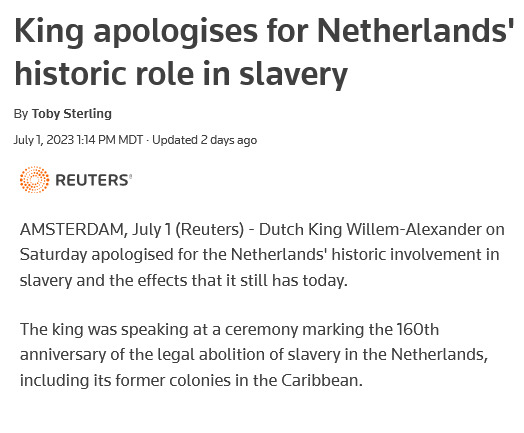
“Dutch King apologizes for Netherlands’ role in slavery.”
The Dutch/Netherlands abducted slaves from West Africa; hosted the Dutch West India Company; operated an extensive profitable sugar plantation industry built on slave labor; and established colonies in the greater Caribbean region including sites at Aruba, Curaçao, Sint Maarten, Bonaire, and the adjacent “Wild Coast” (land between the Orinoco and Amazon rivers, including Guyana and Suriname). Many of these places remained official colonies until between the 1950s and 1990s.
---
Scholarship on resistance to Dutch practices of slavery, colonialism, and imperialism in the Caribbean:
“Decolonization, Otherness, and the Neglect of the Dutch Caribbean in Caribbean Studies.” Margo Groenewoud. Small Axe. 2021.
“Women’s mobilizations in the Dutch Antilles (Curaçao and Aruba, 1946-1993).” Margo Groenewoud. Clio. Women, Gender, History No. 50. 2019.
“Black Power, Popular Revolt, and Decolonization in the Dutch Caribbean.” Gert Oostindie. In: Black Power in the Caribbean. Edited by Kate Quinn. 2014.
“History Brought Home: Postcolonial Migrations and the Dutch Rediscovery of Slavery.” Gert Oostindie. In: Post-Colonial Immigrants and Identity Formations in the Netherlands. Edited by Ulbe Bosma. 2012.
“Other Radicals: Anton de Kom and the Caribbean Intellectual Tradition.” Wayne Modest and Susan Legene. Small Axe. 2023.
Di ki manera? A Social History of Afro-Curaçaoans, 1863-1917. Rosemary Allen. 2007.
Creolization and Contraband: Curaçao in the Early Modern Atlantic World. Linda Rupert. 2012.
“The Empire Writes Back: David Nassy and Jewish Creole Historiography in Colonial Suriname.” Sina Rauschenbach. The Sephardic Atlantic: Colonial Histories and Postcolonial Perspectives. 2018.
“The Scholarly Atlantic: Circuits of Knowledge Between Britain, the Dutch Republic and the Americas in the Eighteenth Century.” Karel Davids. 2014. And: “Paramaribo as Dutch and Atlantic Nodal Point, 1640-1795.” Karwan Fatah-Black. 2014. And: Dutch Atlantic Connections, 1680-1800: Linking Empires, Bridging Borders. Edited by Gert Oostindie and Jessica V. Roitman. 2014.
Decolonising the Caribbean: Dutch Policies in a Comparative Perspective. Gert Oostindie and Inge Klinkers. 2003. And: “Head versus heart: The ambiguities of non-sovereignties in the Dutch Caribbean.” Wouter Veenendaal and Gert Oostindie. Regional & Federal Studies 28(4). August 2017.
Tambú: Curaçao’s African-Caribbean Ritual and the Politics of Memory. Nanette de Jong. 2012.
“More Relevant Than Ever: We Slaves of Suriname Today.” Mitchell Esajas. Small Axe. 2023.
“The Forgotten Colonies of Essequibo and Demerara, 1700-1814.” Eric Willem van der Oest. In: Riches from Atlantic Commerce: Dutch Transatlantic Trade and Shipping, 1585-1817. 2003.
“Conjuring Futures: Culture and Decolonization in the Dutch Caribbean, 1948-1975.” Chelsea Shields. Historical Reflections / Reflexions Historiques Vol. 45 No. 2. Summer 2019.
“’A Mass of Mestiezen, Castiezen, and Mulatten’: Fear, Freedom, and People of Color in the Dutch Antilles, 1750-1850.” Jessica Vance Roitman. Atlantic Studies 14, no. 3. 2017.
---
This list only covers the Caribbean.
But outside of the region, there is also the legacy of the Dutch East India Company; over 250 years of Dutch slavers and merchants in Gold Coast and wider West Africa; about 200 years of Dutch control in Bengal (the same region which would later become an engine of the British Empire’s colonial wealth extraction); over a century of Dutch control in Sri Lanka/Ceylon; Dutch operation of the so-called “Cultivation System” (”Cultuurstelsei”) in the nineteenth century; Dutch enforcement of brutal forced labor regimes at sugar plantations in Java, which relied on de facto indentured laborers who were forced to sign contracts or obligated to pay off debt and were “shipped in” from other islands and elsewhere in Southeast Asia (a system existing into the twentieth century); the “Coolie Ordinance” (”Koelieordonnanties”) laws of 1880 which allowed plantation owners to administer punishments against disobedient workers, resulting in whippings, electrocutions, and other cruel tortures (and this penal code was in effect until 1931); and colonization of Indonesian islands including Sumatra and Borneo, which remained official colonies of the Netherlands until the 1940s.
162 notes
·
View notes